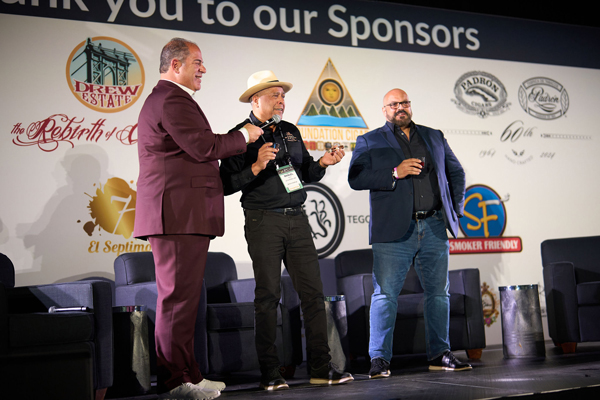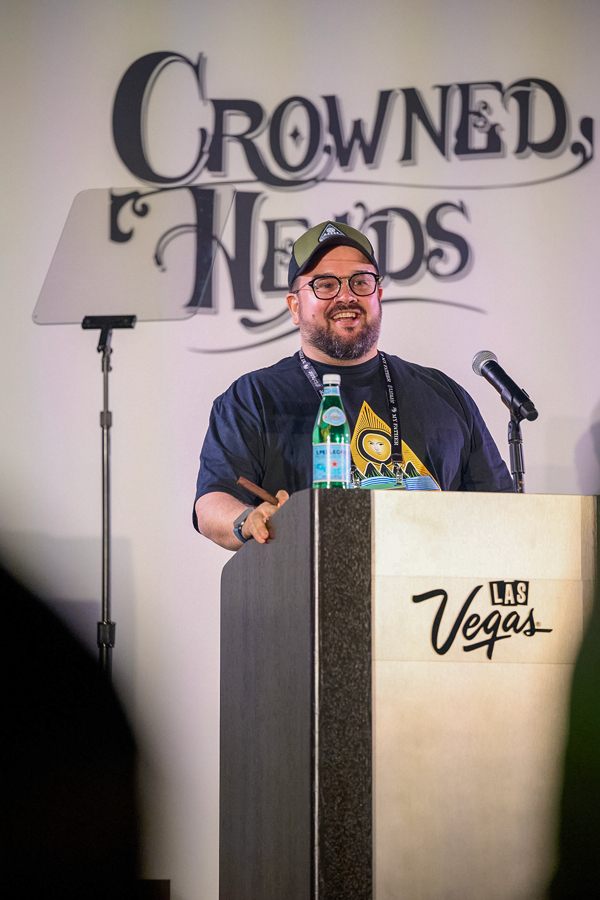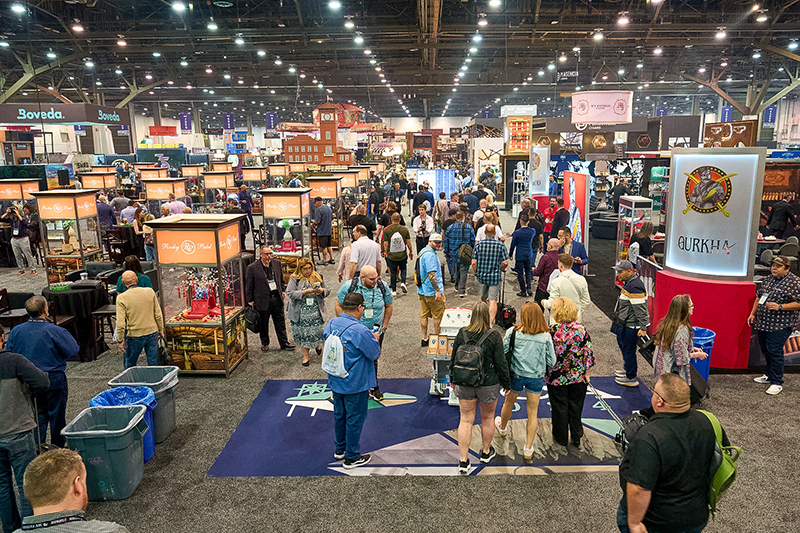Beautiful skies and mild temperatures, with a little bit of wind and rain—not something we usually associate with the annual PCA trade show—but with the dates changed to March, attendees were treated to picture-perfect days during the PCA 2024 Annual Convention and Trade Show. While those attending weren’t able to enjoy the bulk of Nevada’s spring weather, it made for some pleasant evenings after long days of brisk business and valuable networking.
The educational component of the show continued to deliver edifying information on how to better run your business while also celebrating the industry as a whole. Day one kicked off with a series of information sessions that brought a unique breadth of industry perspectives, beginning with a sneak peek into the newest episode of the Handrolled cigar docuseries. The screening featured Pete Johnson and the origins of Tatuaje, with the episode offering viewers a deep dive into the players involved in the cigar boom of the ’90s, including the advent of Cigar Aficionado, the profound influence of George Brightman—a luminary of the industry—on the U.S.’s next generation of cigar makers, and the opening of the Grand Havana Room in Beverly Hills, California. More information on the docuseries will be available this summer.

A Perfect Pairing
Manuel Inoa followed up Handrolled with a cigar pairing seminar for La Aurora’s 120 Year Anniversary cigar. The cigar is an all-Dominican blend, with a Dominican Havana 92 wrapper, an Olor del Valle del Cibao binder and fillers of Corojo, Olor del Valle del Cibao and Piloto Cubano from Valle del Cibao. “We went through 62 different samples to bring this to you,” shared Inoa, while emphasizing the importance of using all the senses of the tongue as well as the nose when enjoying the cigar.
After starting the smoke, and experiencing the cedar aromas and flavors of cinnamon and pepper, Inoa introduced a double-aged rum from the Dominican Republic made by E. León Jimenes. Inoa described the pairing as the perfect match—“The best cigar with the best rum”—and noted that after sipping the rum, a pull on the cigar will offer a richer, more flavorful smoking experience.
Connecticut’s Tobacco Influence
The day then turned educational, with Foundation’s Nick Melillo, the undisputed champion of Connecticut tobacco history, providing a historical tobacco journey through the Connecticut River Valley that has produced some of the most important tobacco varieties in the world. Going back a few eons, Melillo described how melting glaciers and the subsequent river and lake system that emerged created the perfect growing environment for tobacco. Tobacco growing in the Connecticut River Valley began in the 1660s and the first cigar factory was built in 1810 in Suffield, Connecticut.
The three main seed varieties that became a staple wrapper for millions of cigars come from Cuban Havana Seed, Connecticut Broadleaf and Connecticut shade. Owing to weather and the gradual elimination of small farming, since the late 1980s much of the Connecticut tobacco has been grown in other places, most prolifically in Ecuador.

Padrón 60
Padrón is celebrating its 60th anniversary this year, and Jorge Padrón delivered the keynote address for this year’s trade show. “Sixty years ago, with limited resources, my father started Padrón Cigars with one goal, to produce the finest product possible. He did what he could, always understanding that the quality of the product, not the quantity produced, was what established his brand,” said Padrón.
Patriarch José O. Padrón set the guiding principles into the ethos of the company: the importance of family, always be grateful, live with humility and live with integrity. Jorge Padrón shared his vision to carry on that tradition for the next 60 years. Here are a few of his words:
“Many times I’ve been asked, ‘Well, what are you planning for the future?’ And for me, the answer has always been very simple. You first have to focus on maintaining what has already been established. Too many times people try to change something when there’s a change of control in the company. Fortunately, I had enough time by my father’s side to understand that we were on the right path, and all we needed was to just maintain. And sometimes, maintaining is harder than getting there. So, I’ve never taken it for granted that we were at a certain level when my father passed away, that I assumed 100 percent control of the company. But, I knew that we just had to keep doing what we were doing, and focus on the important things.
“Always focusing on the quality over the quantity of supplies produced. And lastly, to preserve the most important asset that we have, the loyalty and trust of all of our customers. The lessons we learned from my father will always continue to serve us well in facing and overcoming possible challenges that lie ahead.
“I’d like to close my comments with one of my father’s favorite sayings by the Cuban poet José Martí: ‘Men are divided into two groups. Those that love and create, and those that hate and destroy.’
“I want to thank my dad for being the one that loved and created. We are all grateful for his work, lessons, unconditional love and support, and for the sacrifices he made in order to put us in a position that we are in today. Both as your children, grandchildren, and as a company. We’re all looking forward to continuing this important legacy entrusted to us for many years to come.”
More Education
On day two, the PCA announced game-changing membership benefits that will provide more attractive incentives to retailer and manufacturer owners and staff with new group health and retirement plans. PCA also announced a special deal on a recruitment program called CareerPlug to help employers find the right people for their business. The health and retirement plans will roll out later this year and into 2025. For more details, see page 13.
The third day of the show wrapped up the educational seminars with a lineup of marketing experts. Gnymble, the business-to-customer texting system that has partnered with PCA for several years now, discussed the benefits of direct-text marketing, if done right. That caveat is important, because people respond to texting differently. While some don’t mind the occasional marketing text, others can have a more unfavorable reaction that could ultimately hurt your business. Not to mention trying to navigate the regulations for advertising tobacco products. So how do you walk that fine line? “We work with you to navigate SHAFT (Sex, Hate, Alcohol, Firearms and Tobacco) advertising regulations and we work with you to target the correct customer marketing lists receptive to texting that I guarantee will make you money,” said Bryan Fine, CEO of Gnymble.
Brandon Frakes, of Industrial Cigar Company, provided a presentation of best practices for business websites. “Your website should be managed like an employee,” said Frakes, meaning once it’s built, don’t ignore it, just like you wouldn’t ignore an employee once hired.
When analyzing your website, Frakes proposes asking yourself several questions, most importantly whether your website is an accurate extension of your business. Is your website gathering moss? And does your website generate revenue? Depending on your answers, “It’s important,” said Frakes, to “not be afraid to kill your baby” if your website is not working for you.

The final presentation consisted of a panel with Ben Wills of Sisters in Smoke, Teresa Wessling of Georgetown Tobacco, and moderated by Mechelle Merkerson of Cigars with “M.” The panel discussed social media best practices and offered some simple steps to maximize your business’s social media presence. Willis emphasized that retailers need to start by “reading the room”—in other words, know your clientele’s wants and needs. Once that is established, then it is understanding your brand’s POV. How do you want to present your business to current and potential customers? What defines your store? Once these questions are answered, a retailer can start to build a message around those two essential components.
As manager of Georgetown Tobacco, and a self-described reluctant social media user, Wessling said the single most important step she took to increase her store’s media presence was creating a content schedule and then sticking to it. “Time is a challenge, and I recognize I’m a tobacconist, not a social media influencer,” she said. By setting up a plan, she said it allowed her to be consistent with her message and to get more comfortable in front of the camera.

The new time of year offered a unique experience for attendees and exhibitors at the trade show, and that singular feeling will continue next year as PCA heads southeast to New Orleans for 2025. We hope to see you there!
– Photography by Arielle Lewis Studio
This story first appeared in PCA The Magazine, Volume 2, 2024. To receive a copy of this magazine you must be a current member of PCA.

